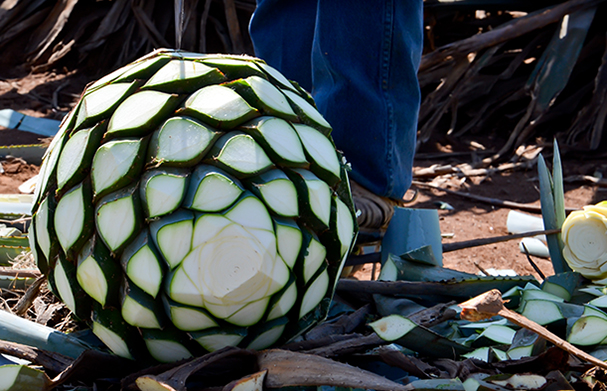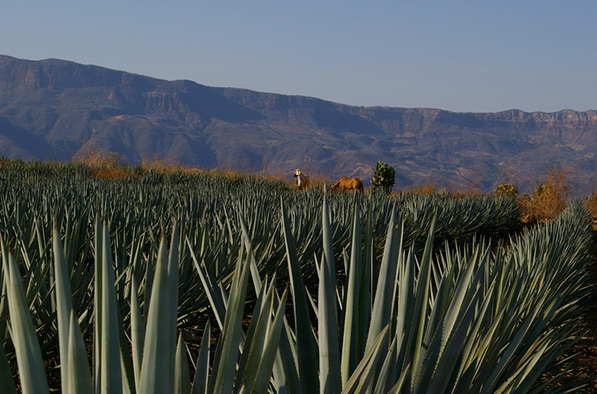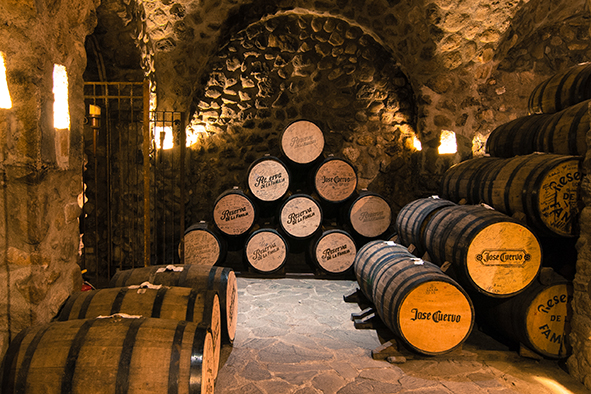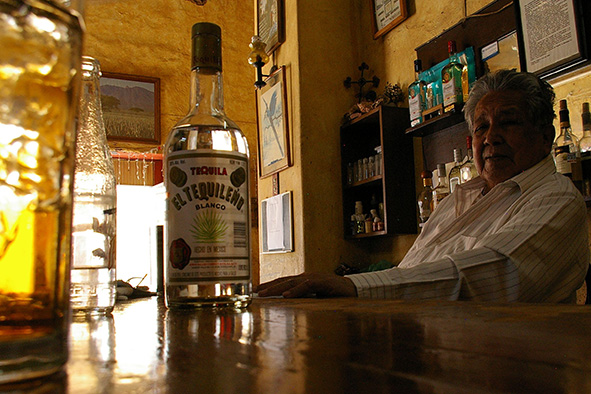In Mexico Tequila was first the name of a town, then it gave its name to the drink beloved of students the world over. But the drink has had a recent makeover of sorts, with versions of the beverage perfect for sipping neat. Stephen Woodman explores Tequila in all its forms.

The Jose Cuervo Express train (Photo: Cesar Ramirez via Flickr)
I’m offered my first tequila cocktail before the train has even departed from Guadalajara station. It’s the first of many drinks served on the Jose Cuervo Express to Tequila, the colonial town that gave its name to Mexico’s national beverage.
The train, a mock-19th-century-railcar, comes to life and slices along the tracks. Past Guadalajara’s gridlocked main avenues and featureless outer districts, we enter greener terrains that slide by soothingly.
Distant cattle graze in wide, beige fields, and all sorts of alien contraptions loom into view: vast water tanks that look like spaceships, maize harvesters from Mars and other spindly structures that have landed from beyond.
I’m sipping a blood-red vampiro, a popular cocktail made with tequila, grapefruit soda and sangrita – a spicy blend of orange juice, red chili, salt and lime.
I know my destination is close when the maize and sugarcane fields outside Guadalajara give way to rolling hills lined with countless rows of spiky blue agave plants.
The regions of Mexico centered on Tequila and the northern state of Tamaulipas are responsible for producing all of the world’s tequila – around 80 million gallons per year.
The spirit has been around since the sixteenth century, when Spanish colonists switched from brandy and started distilling agave. The Cuervo family of Tequila became the first licensed producers more than 250 years ago and the town’s fame as the birthplace of the beverage has led to its designation as a UNESCO World Heritage Site.

The heart of the agave plant (Photo: omarsan via Flickr)
The Spirit of Mexico
Our arrival in Tequila is greeted with a flourish of trumpets. A mariachi band breaks into a thundering version of “Viva Mexico” as the passengers step from the train.
La Rojena, Jose Cuervo’s distillery in the center of town, is the oldest in Latin America. From the outside, the expansive leaf-covered building looks like a monastery.
Inside, the factory is anything but peaceful. A group of workers in red bandanas are collecting what look like gigantic pineapples from a mountainous pile and slicing them down with axes.
The pineapples are in fact the hearts of the spiky agave plants that carpet the surrounding hills. These blue plants are tended for up to nine years, before being harvested and brought here. To make the spirit, the hearts are roasted, pressed and distilled, while the best tequilas are also aged in bourbon barrels.
An educational tasting is offered as part of the tour. As I’m still feeling the effects of multiple vampire cocktails, I’m pretty drunk after a couple of straight shots.
“The secret to knowing whether it’s a good tequila is you pour a drop into your palm and wait for it to dry,” our guide says. “If it retains the aroma of tequila, it has passed the test. If not, it’s a cheap imitation.”

The agave fields outside Tequila (Photo: Thomassin Mickael via Flickr)
From cocktails to connoisseurs
The tour culminates with a visit to the Reserva de la Familia collection, the Cuervo family’s private stock. This underground chamber was closed to the public until 1995, when the family celebrated their bicentenary with the release of its Reserva de la Familia line, an aged, specially-selected tequila that retains the rich flavors of the cellar’s oak barrels.
In recent years, tequila has gone a long way to shedding its international reputation as a party drink to be slammed. Tequilas such as Reserva de la Familia have fostered a more sophisticated image and Mexico’s signature beverage is now recognized as a spirit with a range of flavor comparable to a fine Scotch whisky.
At around $125, or $7.40 per shot, Reserva de la Familia is one of the most expensive tequilas on the market.
Yet even this bottle is a long way from Cuervo’s priciest.
“Our most expensive offering is a recent tribute to the Rolling Stones,” our tour guide says. “This limited edition bottle celebrates Jose Cuervo’s role in fueling The Rolling Stones’ 1972 North American tour. Only 25 bottles were produced and each has a price tag of around $4,000.”

The Reserva de la Familia cellar collection (Photo: Zkropotkine via Flickr)
Such super-premium tequilas are increasingly popular, with celebrities like P Diddy, Justin Timberlake and George Clooney all launching their own spirits.
But not everyone is impressed with the luxury tequila trend. A new skepticism has arisen around the marketing tactics the industry uses to justify its prices. Along with celebrity collaborations, companies are opting for increasingly elaborate bottle designs. Almost every tequila outfit has developed its own romantic account of a secret family recipe handed down the generations.
“Storytelling certainly seems to be a part of what tequila consumers want,” says Clayton Szczech, the founder of Experience Tequila, a company that offers tours of Mexican distilleries.
In the case of the Jose Cuervo and Rolling Stones connection, Szczech says the story is well-documented, although he won’t personally be buying a bottle.
“Is a $4,000 bottle of tequila likely to give me 40 times the pleasure of a $100 bottle of tequila? Almost certainly not. But people in other income brackets, with other relationships to these types of products will feel and behave differently.”

Don Javier Delgado Corona in La Capilla Cantina (Photo: Thomassin Mickael)
The Tequila Chapel
Outside, the afternoon sun has risen to heat the town. A street sweeper in rolled up shirtsleeves brushes debris into a huge metal dustpan. A group of teenagers emerge from a convenience store, laughing and blinking in the light.
I walk down a couple of thin, cobblestone streets until I reach La Capilla “The Chapel,” the oldest cantina in Tequila. The place is so named, the joke goes, because patrons enter on their feet and crawl out on their knees.
Inside is a Mexican bar exactly as foreigners would imagine: rough tiled floors, spindly stools in front of a sticky plywood bar, and saloon doors leading out back. Toothpick in mouth, the barman is wiping down glasses with a dish towel. Several men are airing thoughts over some pale, sweating coronas. The only thing that’s missing are the holstered pistols and hostile glances.
La Capilla’s signature drink, La Batanga, attracts visitors from far and wide. In truth, the cocktail is a simple blend of Coca-Cola, tequila and lime, and the bar’s popularity is as much about its owner as the drink.
Don Javier Delgado Corona, now in his nineties, is a legendary figure in Tequila. You’ll find him smiling behind the bar as he stirs the contents of a cocktail with a wooden-handled knife.
The knife adds flavor to the Batanga, according to Don Javier, because it is also used to cut lime, avocadoes and onions.
Aaron, the manager and Don Javier’s great-nephew, puts the bar’s success down to its owner’s spirit of hospitality.
“He treats everyone with kindness, and he looks after clients as if they were in his own house.”
Aaron is not alone in his assessment. The World’s 50 Best Bars, a British magazine, consistently features La Capilla as one of the world’s greatest drinking destinations, alongside swanky joints in pricey areas of New York and London.
La Capilla’s hospitable owner demonstrates that you don’t need super-premium beverages or swish interior design to create a memorable drinking experience — sometimes the quality of a drink is measured by your company.